Nabonidus
Nabonidus (/ˌnæbəˈnaɪdəs/; Akkadian: 𒀭𒀝𒉎𒌇 dNabû-naʾid, "Nabu is praised") was the last king of the Neo-Babylonian Empire, reigning from 556–539 BC (17 years). He seized power in a coup, toppling King Labashi-Marduk. He also angered the priests and commoners of Babylon by neglecting the city’s chief god, Marduk, and elevating the moon god, Sin, to the highest status. Nabonidus left the capital for ten years to build and restore temples – mostly to Sin – leaving his son, Belshazzar, in charge. While leading excavations for the restoration effort, he initiated the world’s first known archaeological work.
| Nabû-naʾid | |
|---|---|
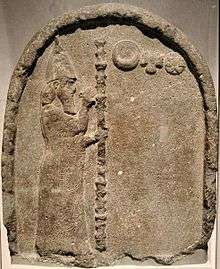 Nabonidus in relief showing him praying to the moon, sun and Venus (British Museum) | |
| King of the Neo-Babylonian Empire | |
| Reign | c. 556–539 BC |
| Predecessor | Labashi-Marduk |
| Successor | Cyrus the Great (by conquering Babylonia) |
| Born | Harran (the city where his mother was priestess) |
| Died | Carmania (his reported exile place) |
| Spouse | Nitocris of Babylon (possibly)[1] |
| Issue | Belshazzar Ennigaldi Nebuchadnezzar III? |
| Father | Nabu-balātsu-iqbi |
| Mother | Addagoppe of Harran |
Meanwhile, the Persian Achaemenid Empire to the east, led by Cyrus the Great, had been gaining strength. King Cyrus had become popular among the residents of Babylon by posing as the one who would restore Marduk to his rightful place in the city. As the Persians advanced to Babylon, Nabonidus returned. He was captured by the Persians in 539 BC and Babylon was occupied, thus ending the Neo-Babylonian Empire. Cyrus was welcomed into the city, where he performed the rites of Marduk. Nabonidus’ fate is uncertain, though it is believed he was exiled to Iran and allowed to occupy a government post.
Historiography
Modern perceptions of Nabonidus' reign have been heavily colored by accounts written well after his reign as king of Babylon, most notably by the Persians and the Greeks. As a result, Nabonidus has often been described in very negative terms in both modern and contemporaneous scholarship. However, an accumulation of evidence and a reassessment of existing material has caused opinions on Nabonidus and the events that happened during his reign to alter significantly in recent decades.[2]
Biography
Ascent
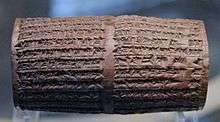
Nabonidus' background is not clear. He said in his inscriptions that he was of unimportant origins. Similarly, his mother Addagoppe, who lived to an old age and may have been connected to the temple of the moon-god Sîn in Harran, does not mention her family background in her inscriptions. There are two arguments for an Assyrian background: repeated references in Nabonidus' royal propaganda and imagery to Ashurbanipal, the last great Neo-Assyrian king; and Nabonidus' originating from, and his special interest in Harran, an Assyrian city and the last stronghold of the Neo-Assyrians after the fall of Nineveh, their main capital.[3] A few inscriptions name Nabonidus’ father, Nabu-balatsu-iqbi, satrap (governor) of Harran and descendant of Esarhaddon, though one brick inscription from Harran lists his name as “Naksu” in place of “Nabu”. Inscriptions title him as The Wise Prince and The Devotee of the Great Gods and Goddesses, however his family is never mentioned, leading to the assumption he died as a young man.[4]
However, it has been pointed out that Nabonidus' royal propaganda was hardly different from his predecessors, while his Persian successor, Cyrus the Great, also referred to Ashurbanipal in the Cyrus cylinder.[5] He certainly did not belong to the previous ruling dynasty, the Chaldeans, of whom Nebuchadnezzar II was the most famous member. He came to the throne in 556 BC by overthrowing the young king Labashi-Marduk.
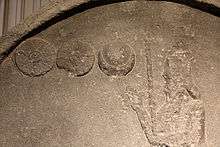
Reign
Nabonidus took an interest in Babylon's past, excavating ancient buildings and displaying his archeological discoveries in a museum. In most ancient accounts, he is depicted as a royal anomaly. Nabonidus is supposed to have worshipped the moon-god Sîn beyond all the other gods, to have paid special devotion to Sîn's temple in Harran, where his mother was a priestess, and to have neglected the Babylonian primary god, Marduk. He left the capital and travelled to conquer the desert oasis city of Tayma in north Arabia early in his reign, from which he only returned after ten years. In the meantime, his son Belshazzar ruled from Babylon.[6]
Contributions
.jpg)
Nabonidus is known as the first archaeologist.[7][8][9] Not only did he lead the first excavations which were to find the foundation deposits of the temples of Šamaš the sun god, the warrior goddess Anunitu (both located in Sippar), and the sanctuary that Naram-Sin built to the moon god, located in Harran, but he also had them restored to their former glory.[7] He was also the first to date an archaeological artifact in his attempt to date Naram-Sin's temple during his search for it.[10] Even though his estimate was inaccurate by about 1,500 years, it was still a very good one considering the lack of accurate dating technology at the time.[10][7][8]
Religious policy
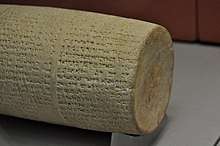
Although Nabonidus' personal preference for Sîn is clear, the strength of this preference divides scholars. While some claim that it is obvious from his inscriptions that he became almost henotheistic,[11] others consider Nabonidus to have been similar to other Babylonian rulers, in that he respected the other cults and religions in his kingdom.[12] His negative image could then be blamed on the Marduk priesthood, that resented Nabonidus' long absence from Babylon during his stay in Tayma, during which the important, Marduk-related New Year (Akītu-) Festival could not take place, and his emphasis on Sîn. In any case, there is no sign of the civil unrest during his reign that would have been indicative of trouble.
Part of the propaganda issued by both the Marduk priesthood and Cyrus is the story of Nabonidus taking the most important cultic statues from southern Mesopotamia hostage in Babylon. This seems to be correct: a great number of contemporary inscriptions shows that these statues and their cultic personnel were indeed brought to Babylon just before the Persian attack:
"In the month of [Âbu?] Lugal-Marada and the other gods of the town Marad, Zabada and the other gods of Kish, the goddess Ninlil and the other gods of Hursagkalama visited Babylon. Till the end of the month Ulûlu all the gods of Akkad -those from above and those from below- entered Babylon. The gods of Borsippa, Cutha, and Sippar did not enter."
However, modern scholarship has provided an explanation for this action. In Mesopotamia, gods were supposed to be housed inside their statues, from where they took care of their cities. But this only happened if they received the right kind of attention. So Nabonidus took special care of these statues and made sure that their cultic personnel had to come along with him.[13] This was a long-standing tradition, too:
"One of the most powerful illustrations of the strength and conviction of image worship in ancient Mesopotamia is probably the treatment of cult statues in times of war. Assyrian and Babylonian sources of the first millennium frequently allude to the removal of divine statues from the temples as the result of a city being conquered. Spoliated statues were usually carried off to the land of the victorious power (Assyria in most known cases) where they remained in captivity until a turn of events would allow them to be restored to their shrines. (...) Rather than incur the capture of their gods and the resulting implications of such capture, namely, that the gods were abandoning the city and calling for its destruction, cities often tried to prevent the transfer of the statues to enemy territory, since continued possession of them in the face of adversity proved that the gods were still protecting and supporting their people and native land. (...) [D]uring the months which preceded the invasion and conquest of Babylonia by the Persians in 539 BC, King Nabonidus ordered a massive gathering of the gods of Sumer and Akkad into the capital. Unlike previous attempts, the gathering ordered by Nabonidus is documented by a number of historical and archival sources." [after this, Beaulieu goes on to discuss these sources in detail]
— P.-A. Beaulieu 1993:241-2
But this exposed him to criticism from his enemies, notably Cyrus. Cyrus was trying to show why he was a better king than Nabonidus had been, and took this as an example of Nabonidus' lack of fitness to rule.[14] In the words of, again, Beaulieu:
"The returning of the statues to their sanctuaries provided Cyrus with one of his many propagandistic anti-Nabonidus themes. Not content with re-establishing the gods in their residence, he charged the deposed king with having brought them to the capital against their will."
— P.-A. Beaulieu 1993:243
And in the words of Cyrus himself, as recorded on the Cyrus Cylinder, found in Babylon in 1879:
"As for the gods of Sumer and Akkad which Nabonidus, to the wrath of the lord of the gods, brought to Babylon, at the command of Marduk, the great lord, I (Cyrus) caused them to dwell in peace in their sanctuaries, (in) pleasing dwellings. May all the gods I brought (back) to their sanctuaries plead daily before Bel and Nabu for the lengthening of my days, may they intercede favorably on my behalf."
— Cyrus Cylinder, 30–34
This is confirmed by the Babylonian Chronicles:
"From the month of Kislîmu to the month of Addaru, the gods of Akkad which Nabonidus had made come down to Babylon, were returned to their sacred cities."
Nabonidus' stay in Tayma
It is not clear yet why Nabonidus stayed in Tayma for so long. One reason for going there, is that Tayma was an important oasis, from where lucrative Arabian trade routes could be controlled. The Assyrians before him had already attempted to do the same.[15] However, why Nabonidus stayed for so long (probably about ten years, perhaps from 553–543 BC) and why he returned when he did remain unresolved questions. It has been proposed that this was because he did not feel at home in Babylon, which was opposed to his emphasis on Sîn. Regarding his return, this may have had to do with the mounting threat of Cyrus and growing disagreements with Belshazzar, who was relieved of his command directly after Nabonidus had come back, along with a number of administrators.[16] During his stay, Nabonidus adorned Tayma with a complex of royal buildings, most of which have come to light during recent excavations.[17]
The Persian conquest of Babylonia
Different accounts of the fall of Babylon survive. According to the Cyrus Cylinder, the people opened their gates for Cyrus and greeted him as their liberator. Isaiah 40–55 prophesied that the Persians would carry off Babylonian women and cultic statues. Herodotus said that Cyrus defeated the Babylonians outside their city, after which a siege began. When this took too long, Cyrus diverted the Euphrates, so that his troops could march into the city through the river bed.[21] Xenophon had a similar view, but he did not mention the battle.[22] Finally, Berossus claimed that Cyrus beat the Babylonian army but, this time, Nabonidus was supposed to have fled to nearby Borsippa. There he hid, while Cyrus took Babylon and demolished its outer walls. When Cyrus turned towards Borsippa, Nabonidus soon surrendered.[23]
As these accounts contradict each other, (the Cyrus Cylinder and Isaiah; for the latter, see Cyrus in the Judeo-Christian tradition), oral traditions (Herodotus and Xenophon) and conflicting records (Berossus), they are quite confusing. The Nabonidus Chronicle is more helpful. This is a part of the Babylonian Chronicles, which are concise, factual accounts of historical events, and are therefore considered to be very reliable, although not very informative.[24] Regarding the capture of Babylon by Cyrus, this text says:
"In the month of Tašrîtu, when Cyrus attacked the army of Akkad in Opis on the Tigris, the inhabitants of Akkad revolted, but he massacred the confused inhabitants. The fifteenth day [12 October], Sippar was seized without battle. Nabonidus fled. The sixteenth day, Gobryas [litt: Ugbaru], the governor of Gutium, and the army of Cyrus entered Babylon without battle. Afterwards, Nabonidus was arrested in Babylon when he returned there. Till the end of the month, the shield carrying Gutians were staying within Esagila but nobody carried arms in Esagila and its buildings. The correct time for a ceremony was not missed. In the month of Arahsamna, the third day [29 October], Cyrus entered Babylon, green twigs were spread in front of him - the state of peace was imposed upon the city. Cyrus sent greetings to all Babylon. Gobryas, his governor, installed subgovernors in Babylon."
Additionally, a building inscription has been found which mentions the restoration of the Enlil Gate of Babylon shortly after its capture.[25] When Cyrus attempted to march into southern Mesopotamia, he was met by the Babylonians near Opis. In the ensuing battle, the Persians were victorious. This in turn led to the nearby city of Sippar surrendering without a fight, while Nabonidus fled with a small detachment of his force for refuge at Borsippa.[26] In the meantime, the Babylonians had withdrawn south to establish a line of defense near the Euphrates that was intended to prevent Cyrus from advancing too far. However, Cyrus' forces did not challenge the Babylonian army. Rather, he sent a small force south along the Tigris to try to take the capital by surprise. This plan worked: the Persian troops reached Babylon undetected and caught it unawares, meeting only minor resistance near one of its gates.[27] Thus, they were able to capture Babylon.
This left the Babylonian army in an untenable position, and it soon surrendered. Sometime thereafter Nabonidus returned from Borsippa, where he had retreated, and was captured at Babylon.[28] Ugbaru, the commander of the Persian forces that had captured Babylon, had taken good care that his men should not plunder or otherwise harm the city. He had even made sure that the temple rites continued to be observed.[29] Nonetheless, it still took Cyrus almost a month before he proceeded towards the city. As many Babylonian officials, as well as the Babylonian administrative system, stayed in place after the transition of power, it has been surmised that this time was spent on negotiations with representatives from the city;[30] this is similar to what happened when the Neo-Assyrian king Sargon II and later Alexander the Great took the city.[31]
Death
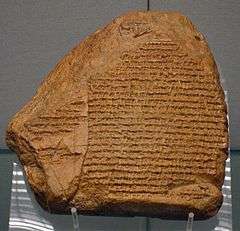
The final fate of Nabonidus is uncertain. Cyrus was known to spare the lives of some kings he had defeated, for example, King Croesus of Lydia, who, after his defeat, was allowed to live at King Cyrus's court as an advisor. This is according to Herodotus, who also states that Croesus was first sentenced to death by burning and was only allowed to live after showing his wisdom.[32] In the reference in the Nabonidus Chronicle to a campaign by Cyrus in (possibly) 547 BC, during which a country was taken and its king killed, the text showing the name of the country is damaged, although it may be Urartu.[33] Berossus and the ex eventu Dynastic Prophecy indicate he was spared by Cyrus after his surrender at Babylon, and allowed to retire and live out the rest of his life in Carmania.[28]
In popular culture
- Nabonidus is portrayed by Carl Stockdale in D. W. Griffith's classic 1916 silent film Intolerance.
See also
- Babylonia
- Belshazzar
- Kings of Babylonia
- Cylinder of Nabonidus
- Ennigaldi ("Ennigaldi-Nanna"), daughter
- Nabonidus Chronicle
- Croesus
References
- Dougherty 2008, p. 43.
- See for example in W. von Soden, “Kyros und Nabonid: Propaganda und Gegenpropaganda”, in H. Koch and D.N. MacKenzie (eds.), Kunst, Kultur und Geschichte der Achämenidenzeit und ihr Fortleben (Berlin: Dietrich Reimer 1983), 61–8; P.-A. Beaulieu, The reign of Nabonidus king of Babylon 556-539 B.C. (New Haven CT: Yale University Press 1989); A. Kuhrt, “Nabonidus and the Babylonian priesthood”, in M. Beard and J. North (eds.), Pagan priests: Religion and power in the ancient world (London: Duckworth), 117-55; F. Grant, “Nabonidus, Nabû-šarra-uṣur, and the Eanna temple”, in Zeitschrift für Assyriologie 81 (1991:37–86); T.G. Lee, “The jasper cylinder seal of Aššurbanipal and Nabonidus’ making of Sîn’s statue”, in Revue d’Assyriologie 87 (1993:131-6); P. Machinist and H. Tadmor, “Heavenly wisdom”, in M.E. Cohen, D.C. Snell and D.B. Weisberg (eds.), The tablet and the scroll: Near Eastern studies in honour of William W. Hallo (Bethesda MD: CDL Press 1993), 146–51; H. Schaudig, Die Inschriften Nabonids von Babylon und Kyros’ des Großen samt den in ihrem Umfeld entstandenen Tendezschriften: Textausgabe und Grammatik (Münster: Ugarit-Verlag 2001); P.-A. Beaulieu, “Nabonidus the mad king: A reconsideration of his steles from Harran and Babylon”, in M. Heinz and M.H. Feldman (eds.), Representations of political power: Case histories from times of change and dissolving order in the ancient Near East (Winona Lake IN: Eisenbrauns 2007), 137–66.
- W. Mayer, "Nabonidus Herkunft", in M. Dietrich and O. Loretz (eds.), Dubsar anta-men: Studien zur Altorientalistik (Münster: Ugarit-Verlag 1998), 245–61; Parpola, Simo (2004). "National and Ethnic Identity in the Neo-Assyrian Empire and Assyrian Identity in Post-Empire Times" (PDF). Journal of Assyrian Academic Studies. JAAS. 18 (2): 19. Archived from the original (PDF) on 2011-07-17. Retrieved 2007-10-24. Similarly: Parpola, Simo. "Assyrians after Assyria". University of Helsinki, The Neo-Assyrian Text Corpus Project (State Archives of Assyria).
- Wolfgang Röllig: Erwägungen zu neuen Stelen König Nabonids. In: Zeitschrift für Assyriologie und Vorderasiatische Archäologie. Band 56, 1964, S. 218–260, hier S. 237.
- A. Kuhrt, "'Ex oriente lux': How we may widen our perspectives on ancient history", in R. Rollinger, A. Luther and J. Wiesehöfer (eds.), Getrennte Wege? Kommunikation, Raum und Wahrnehmung in der alten Welt (Frankfurt am Main: Verlag Antike 2007), 617–32.
- "krc2.orient.ox.ac.uk" (PDF).
- Silverberg, Robert (1997). Great Adventures in Archaeology. University of Nebraska Press. p. viii. ISBN 978-0-8032-9247-5.
- Kelly, Robert L.; Thomas, David Hurst (2013). Archaeology: Down to Earth. Cengage Learning. p. 2. ISBN 978-1-133-60864-6.
- Watrall, Ethan. "ANP203-History-of-Archaeology-Lecture-2". Anthropology.msu.edu. Retrieved 7 April 2014.
- Hirst, K. Kris. "The History of Archaeology Part 1". ThoughtCo.com. Retrieved April 5, 2014.
- Beaulieu 1989:46–65; Machinist/Tadmor 1993.
- Kuhrt 1990.
- P.-A. Beaulieu, "An episode in the fall of Babylon to the Persians", Journal of Near Eastern Studies 52 (1993:241-61)
- Beaulieu 1993; A. Kuhrt, "The Cyrus Cylinder and Achaemenid imperial policy", Journal for the Study of the Old Testament 25 (1983:83–97).
- Beaulieu 1989:149–205. On Tayma's importance for trade: C. Edens and G. Bawden, "History of Tayma' and Hejazi trade during the first millennium B.C.", Journal of the Economic and Social History of the Orient 32 (1989:48–103).
- Beaulieu 1989:149–205.
- An overview of the history of Tayma, current archaeological work, as well as bibliographical references, are given in "Deutsches Archäologisches Institut: Tayma". Archived from the original on 2007-10-23. Retrieved 2007-10-16. Also: H. Hayajneh, "First evidence of Nabonidus in the Ancient North Arabian inscriptions from the region of Tayma", Proceedings of the Seminar for Arabian Studies 31 (2001:81–95).
- British Museum Collection
- Cuneiform inscriptions, Vol 5 (PDF). 1905. p. Item 64.
- "Nabonidus Cylinder from Sippar - Livius". www.livius.org.
- Herodotus, Histories 1.188–191
- Xenophon, Cyropaedia 7.5.1–36
- From the Babyloniaca: Fragmente der griechischen Historiker 680F9a = Flavius Josephus, Against Apion 1.149–153.
- R.J. van der Spek, ""Review of J.-J. Glassner, Mesopotamian chronicles (ed. B. Foster) (Leiden: Brill 2004)" (PDF).", Review of Biblical Literature (2005/09).
- P. Briant, From Cyrus to Alexander: A history of the Persian Empire (Winona Lake IN: Eisenbrauns 2002), 50–5, 80–7; G. Tolini, ""Quelques éléments concernant la prise de Babylon par Cyrus (octobre 539 av. J.-C.)" (PDF).", Arta (2005/03); A. Kuhrt, ""Ancient Near Eastern history: The case of Cyrus the Great of Persia" (PDF).", in H.G.M. Williamson (ed.), "Understanding the history of ancient Israel". (Oxford: Oxford University Press 2007), 107–27.
- Beaulieu, Paul-Alain (1989). The Reign of Nabonidus, King of Babylon 556-539 B.C. New Haven and London: Yale University Press. p. 230. ISBN 0-300-04314-7.
- P. Briant, From Cyrus to Alexander: A history of the Persian Empire (Winona Lake IN: Eisenbrauns 2002), 50–5, 80–7; G. Tolini, ""Quelques éléments concernant la prise de Babylon par Cyrus (octobre 539 av. J.-C.)" (PDF).", Arta (2005/03); A. Kuhrt, ""Ancient Near Eastern history: The case of Cyrus the Great of Persia" (PDF).", in H.G.M. Williamson (ed.), "Understanding the history of ancient Israel". (Oxford: Oxford University Press 2007), 107–27.
- Beaulieu, Paul-Alain (1989). The Reign of Nabonidus, King of Babylon 556-539 B.C. New Haven and London: Yale University Press. p. 231. ISBN 0-300-04314-7.
- Grayson, A. Kirk (1975). Assyrian and Babylonian Chronicles. Locust Valley, NY: J.J. Augustin. p. 110. ISBN 1-57506-049-3.
- J. Wiesehöfer, "Kontinuität oder Zäsur? Babylon under den Achaimeniden", in J. Renger (ed.), Babylon: Focus Mesopotamischer Geschichte, Wiege früher Gelehrsamheit, Mythos in der Moderne (Saarbrücken: SDV 1999), 167–88; M. Jursa, "The transition of Babylonia from the Neo-Babylonian empire to Achaemenid rule", in H. Crawford (ed.), Regime change in the ancient Near East and Egypt: From Sargon of Agade to Saddam Hussein (New York: Oxford University Press 2007), 73–94.
- Kuhrt 2007 ("'Ex oriente lux'...").
- 1.86–88
- J. Oelsner, "Review of R. Rollinger, Herodots babylonischer logos: Eine kritische Untersuchung der Glaubwürdigkeitsdiskussion (Innsbruck: Institut für Sprachwissenschaft 1993)", Archiv für Orientforschung 46/47 (1999/2000:378-80); R. Rollinger, "The Median "empire", the end of Urartu and Cyrus' the Great campaign in 547 B.C. (Nabonidus Chronicle II 16)", Ancient West & East 7 (2008:49–63).
External links
- Cylinder of Nabonidus at the British Museum.
- Nabonidus Cylinder from Sippar Translation.
- Nabonidus Cylinder from Ur Translation.
- Lihyanite inscription of Nabonidus, at Nat. Museum of Natural History site
- Nabonidus archaeology
| Preceded by Labashi-Marduk |
King of Babylon 556–539 BC |
Succeeded by Nebuchadnezzar III (Self-proclaimed) |
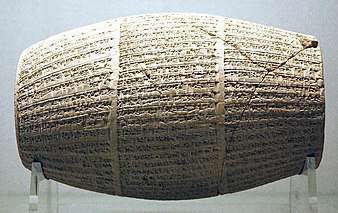
.jpg)